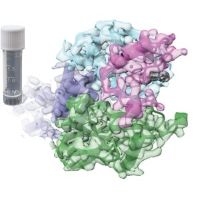Specification
| Description | Recombinant protein from the full-length sequence of Homo sapiens heat shock transcription factor 1 (HSF1) (NM_005526). |
| Organism | Homo sapiens (Human) |
| Expression Host | Human Cells |
| Tag Info | His or DYKDDDDK. Please contact us if you need further information or require specific designed tag. |
| Purity | Greater than 90% by SDS-PAGE gel |
| Uniprot ID | Q00613 |
| Entry Name | HSF1_HUMAN |
| Gene Names | HSF1 HSTF1 |
| Alternative Gene Names | HSTF1 |
| Alternative Protein Names | Heat shock factor protein 1 (HSF 1) (Heat shock transcription factor 1) (HSTF 1) |
| Application | Antigens, Western, ELISA and other in vitro binding or in vivo functional assays, and protein-protein interaction studies; For research & development use only! |
| Buffer | Purified protein formulated in a sterile solution of PBS buffer, pH7.2, without any preservatives |
| Endotoxin | Endotoxin level is < 0.1 ng/µg of protein (<1EU /µg) |
| Length | 529 |
| Molecular Weight(Da) | 57260 |
| Protein Sequence | (The sequence of expressed protein may have some variation from the sequence shown below. Please contact us for the exact sequence.) MDLPVGPGAAGPSNVPAFLTKLWTLVSDPDTDALICWSPSGNSFHVFDQGQFAKEVLPKYFKHNNMASFVRQLNMYGFRKVVHIEQGGLVKPERDDTEFQHPCFLRGQEQLLENIKRKVTSVSTLKSEDIKIRQDSVTKLLTDVQLMKGKQECMDSKLLAMKHENEALWREVASLRQKHAQQQKVVNKLIQFLISLVQSNRILGVKRKIPLMLNDSGSAHSMPKYSRQFSLEHVHGSGPYSAPSPAYSSSSLYAPDAVASSGPIISDITELAPASPMASPGGSIDERPLSSSPLVRVKEEPPSPPQSPRVEEASPGRPSSVDTLLSPTALIDSILRESEPAPASVTALTDARGHTDTEGRPPSPPPTSTPEKCLSVACLDKNELSDHLDAMDSNLDNLQTMLSSHGFSVDTSALLDLFSPSVTVPDMSLPDLDSSLASIQELLSPQEPPRPPEAENSSPDSGKQLVHYTAQPLFLLDPGSVDTGSNDLPVLFELGEGSYFSEGDGFAEDPTISLLTGSEPPKAKDPTVS |
Background
| Function | FUNCTION: Functions as a stress-inducible and DNA-binding transcription factor that plays a central role in the transcriptional activation of the heat shock response (HSR), leading to the expression of a large class of molecular chaperones heat shock proteins (HSPs) that protect cells from cellular insults' damage (PubMed:1871105, PubMed:11447121, PubMed:1986252, PubMed:7760831, PubMed:7623826, PubMed:8946918, PubMed:8940068, PubMed:9341107, PubMed:9121459, PubMed:9727490, PubMed:9499401, PubMed:9535852, PubMed:12659875, PubMed:12917326, PubMed:15016915, PubMed:25963659, PubMed:26754925). In unstressed cells, is present in a HSP90-containing multichaperone complex that maintains it in a non-DNA-binding inactivated monomeric form (PubMed:9727490, PubMed:11583998, PubMed:16278218). Upon exposure to heat and other stress stimuli, undergoes homotrimerization and activates HSP gene transcription through binding to site-specific heat shock elements (HSEs) present in the promoter regions of HSP genes (PubMed:1871105, PubMed:1986252, PubMed:8455624, PubMed:7935471, PubMed:7623826, PubMed:8940068, PubMed:9727490, PubMed:9499401, PubMed:10359787, PubMed:11583998, PubMed:12659875, PubMed:16278218, PubMed:25963659, PubMed:26754925). Activation is reversible, and during the attenuation and recovery phase period of the HSR, returns to its unactivated form (PubMed:11583998, PubMed:16278218). Binds to inverted 5'-NGAAN-3' pentamer DNA sequences (PubMed:1986252, PubMed:26727489). Binds to chromatin at heat shock gene promoters (PubMed:25963659). Plays also several other functions independently of its transcriptional activity. Involved in the repression of Ras-induced transcriptional activation of the c-fos gene in heat-stressed cells (PubMed:9341107). Positively regulates pre-mRNA 3'-end processing and polyadenylation of HSP70 mRNA upon heat-stressed cells in a symplekin (SYMPK)-dependent manner (PubMed:14707147). Plays a role in nuclear export of stress-induced HSP70 mRNA (PubMed:17897941). Plays a role in the regulation of mitotic progression (PubMed:18794143). Plays also a role as a negative regulator of non-homologous end joining (NHEJ) repair activity in a DNA damage-dependent manner (PubMed:26359349). Involved in stress-induced cancer cell proliferation in a IER5-dependent manner (PubMed:26754925). {ECO:0000269|PubMed:10359787, ECO:0000269|PubMed:11447121, ECO:0000269|PubMed:11583998, ECO:0000269|PubMed:12659875, ECO:0000269|PubMed:12917326, ECO:0000269|PubMed:14707147, ECO:0000269|PubMed:15016915, ECO:0000269|PubMed:16278218, ECO:0000269|PubMed:17897941, ECO:0000269|PubMed:1871105, ECO:0000269|PubMed:18794143, ECO:0000269|PubMed:1986252, ECO:0000269|PubMed:25963659, ECO:0000269|PubMed:26359349, ECO:0000269|PubMed:26727489, ECO:0000269|PubMed:26754925, ECO:0000269|PubMed:7623826, ECO:0000269|PubMed:7760831, ECO:0000269|PubMed:7935471, ECO:0000269|PubMed:8455624, ECO:0000269|PubMed:8940068, ECO:0000269|PubMed:8946918, ECO:0000269|PubMed:9121459, ECO:0000269|PubMed:9341107, ECO:0000269|PubMed:9499401, ECO:0000269|PubMed:9535852, ECO:0000269|PubMed:9727490}.; FUNCTION: (Microbial infection) Plays a role in latent human immunodeficiency virus (HIV-1) transcriptional reactivation. Binds to the HIV-1 long terminal repeat promoter (LTR) to reactivate viral transcription by recruiting cellular transcriptional elongation factors, such as CDK9, CCNT1 and EP300. {ECO:0000269|PubMed:27189267}. |
| Pathway | |
| Protein Families | HSF family |
| Tissue Specificity |
QC Data
| Note | Please contact us for QC Data |
| Product Image (Reference Only) |  |

